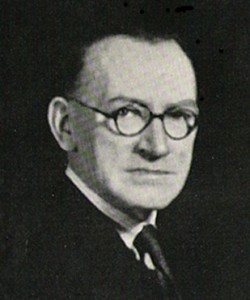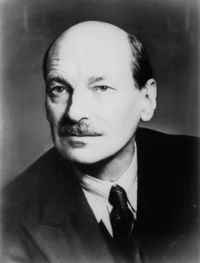by Pete Goddard and Atul Hatwal
The Communists’ attempts to affiliate to the Labour party might have been resoundingly rejected at the 1936 Labour conference, but they didn’t give up that easily.
The Socialist League faction within the Labour party, led by ex-Communist J.T.Murphy, and funded by Stafford Cripps, convened three-way negotiations with the disaffiliated Independent Labour Party, and the Communist party to discuss a “united front.”
For People’s Front of Judea aficionados, it’s important to note the difference between a “united front” and the idea of a “popular front,” that was also gaining support at this time.
A “popular front” meant a broad coalition of Labour, Liberals and assorted leftish types, in the style of Leon Blum’s socialist-led French government or the Spanish republican government. Some by-elections at this time had seen successful co-operation between Liberals and Labour in this manner.
In contrast, the “united front” featured only organisations pure of heart, class-conscious and electorally irrelevant. This meant the ILP, the Socialist League and the Communist Party, who all wanted to join forces with the Labour party, mostly because of the ‘electorally irrelevant’ in the previous sentence.
The leaders of the left-factions squabbled their way through Autumn 1936 in back-room meetings before finally coming to an agreement on what became termed a “Unity manifesto”. This called for, “unity for all sections of the working class movement within the framework of the Labour party and the trade unions.”
The Labour leadership were unimpressed. Experience with these putative partners had proven anything but unifying. And anyway, conference had already voted and it was all now getting rather annoying.
On the 8th January 1937 Labour’s NEC met and decided that if the Socialist League pressed on with this project it would be expelled from the Labour party, rendering the Unity Manifesto a surefire winner of that year’s ‘most ironically titled document’ competition.
On the 13th January, just so no-one was in any doubt, the party issued a circular entitled “Party loyalty – an appeal to the movement,” which underlined the prospect of disaffiliation for the Socialist League.
Cripps and his Socialist League colleagues weren’t backing down. A conference of Socialist League delegates met in London on the 16th and 17th January to formally approve the manifesto. The gathered for the event in a West end tea room, failing to spot that if you can hold your conference in a tea room, you might not be the political powerhouse you think you are.
Unfortunately for Cripps and Murphy, neither had bothered to keep their members informed of events and many were surprised and dismayed to learn they faced expulsion from the Labour Party.
In the end, Cripps convinced enough worried delegates that the meanies in Labour wouldn’t be disaffiliating anyone anytime soon. The conference narrowly agreed the “unity manifesto” by 56 votes to 38 with 23 abstentions, followed by a landslide vote in favour of another slice of Battenberg.
Ten days later, on the 27th January, the meanies in Labour disaffiliated the Socialist League.
Oops.
It got worse. The hawks on the NEC, led by union men Arthur Greenwood and Ernest Bevin wanted to go further and pushed for expulsion of the rebels. Mind you, Bevin probably would have lobbied for executions and heads on spikes too if he thought he could get away with it, he was that sort of guy.
Labour’s leader Clement Attlee tried to defend his friend Cripps, and managed to delay punitive action, but the union leaders were not to be denied.
On March 24th the NEC announced that members of the Socialist League would be ineligible for membership of the Labour party from 1st June.
Cripps and the League were faced with a stark choice: stick to the unity plan and separate from Labour, or give up and remain together.
Ever the lawyer, Cripps devised a way to have his cake, eat it and still bill someone for the time spent scoffing cake.
He decided that the Socialist League would dissolve itself, rendering disaffiliation threats redundant. On top of that, if individual members wanted to still support the Unity movement, well, Labour hadn’t published a memo, minute or circular about that had it?
Clever, but it only bought them a little time. The prospect of a guerrilla movement of plain-clothes unity front-ers in the Labour ranks was unsuprisingly unappealing to the NEC.
They made new rules promising penalties for Labour members appearing on platforms with either communists or the ILP, for working with them in any way or pretty much anything else that fell short of administering a vicious wedgie on seeing a communist in the street.
With no other options open, Cripps and his insurgent colleagues finally gave in. There was to be no joint activity or campaigning of any sort after the Socialist League was disbanded.
For their part, the communists weren’t so bothered. New orders from Moscow meant they were busy purging other left factions over in Spain and consequently the British communists were no longer prepared to share platforms with enemy lefties either.
Unity was so over.
For the leadership this didn’t just represent an internal victory, it created valuable political space for the party to shift its policy platform.
Over the past months the Labour leadership had been inching towards a new, more interventionist position on foreign affairs; a position that would ultimately take them quite close to the Communist line on issues like intervention in Spain.
Agreeing with the Commies on policy while purging their mates from party and refusing any form of alliance with them would have been too confusing, even for Labour. Now that unity was off the agenda, that awkwardness could be avoided.
Prior to Labour conference in 1937, the leadership issued a new statement on international affairs which stated that the League of Nations, “For the time being, has been rendered ineffective,” and stressed the importance of “Improving Anglo-American relations,” in this new world. Of the Soviet Union there was no mention.
Importantly, the statement also demanded an end to non-intervention in Spain, and noted that “in the present state of the world [a Labour government], must be strongly equipped to defend this country, to play its full part in collective security, and to meet any intimidation by the Fascist Powers.”
In other words, they would no longer vote against the defence estimates.
Labour was finally preparing for war with the Fascists. Yes, it technically meant the party was now committed to helping the Communists in Spain, but at least they were communists in Spain, not Transport House.
Pete and Atul are not historians
Tags: Atul Hatwal, communists, Labour history uncut, Pete Goddard, Socialist League, Spain, Stafford Cripps












nother cracking instalment. There was a time when you could say in all honesty: ‘Some of my best friends were Commies’.
If the Communists before and just after the war were a danger to Labour the Militant tendency in the eighties made Labour unelectable. Good riddance to both.